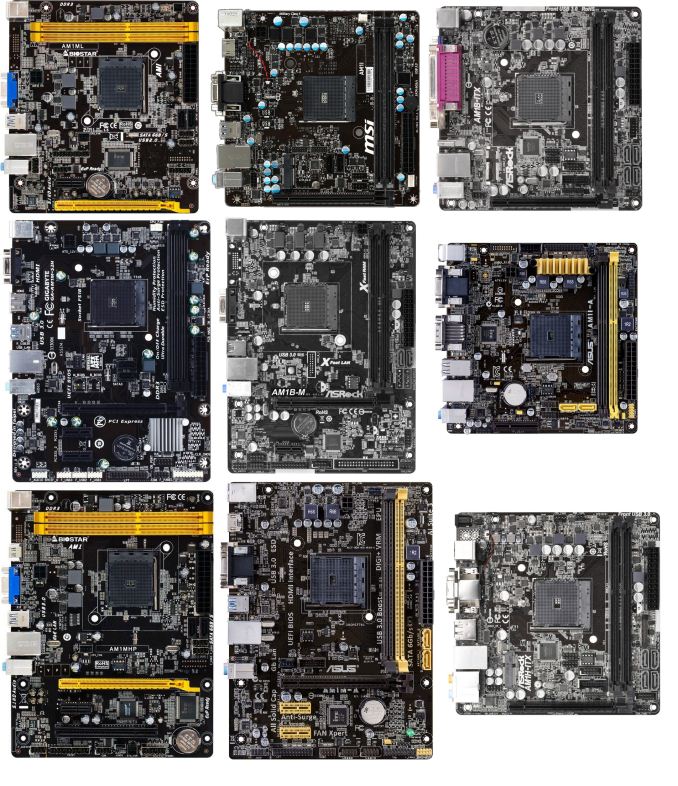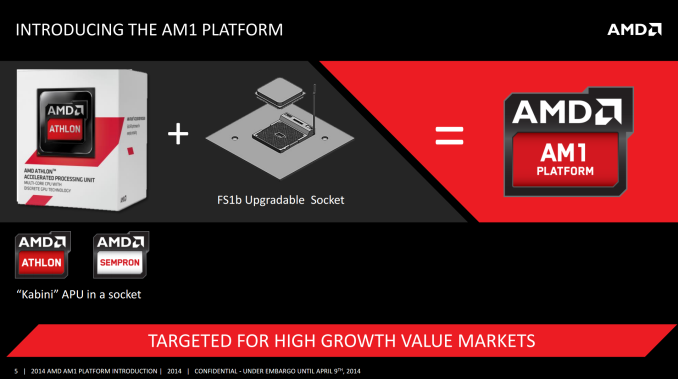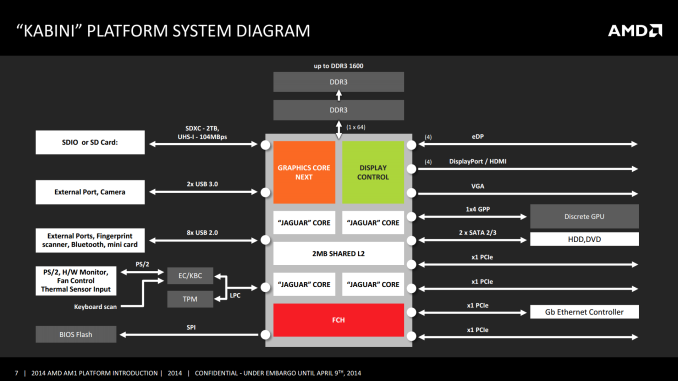The AM1 Kabini Motherboard Preview: Analyzing the Hardware
by Ian Cutress on April 19, 2014 2:00 PM EST
One of AMD’s primary feature points for the AM1 Kabini platform was the introduction of low-cost motherboards. The promotional material provided gave a suggested AM1 combined price of $60. Now after release the cheapest APUs are $31 for a dual core and $35 for a quad core. This should mean motherboards from $29 and up. Today we take a brief preview of nine motherboards currently on sale, which start at $33.
The AM1 Ecosystem
Almost every end-user I converse with prefers naming consistency in technology products. There has to be a clear progression in naming structure showing the development of a platform over time and generations. There have been plenty of examples – AMD’s enthusiast chipset (580/690/790/890/990FX), both AMD and NVIDIA’s GPU lines, Intel’s chipsets (P35, X48, P55, P67, Z77, Z87). The issue arises when the naming scheme is non-contiguous. The naming of AMD’s three main processor and chipset lines are as follows:
The top end features the AM3+ socket, which came from AM3, AM2+ and AM2. The mid-range is the FM2+ socket, deriving from FM2 and FM1. The low-price segment is now being called the ‘AM1 platform’. It makes it sound like it should be a very old version of AM3, because at least colloquially it will just be called AM1. In reality, that word ‘platform’ is the kicker here, because the socket is actually called FS1b:
What makes it called the AM1 platform is the use of a Kabini APU in an FS1b upgradable socket. That does not help that all the motherboards on sale will be given the AM1 designation. This means that if the next iteration of the Athlon processors using ‘Puma’ cores (codename “Beema”) comes along and they call it the ‘AM2 platform’ (insert more confusion with the AM2 socket), it might still be the FS1b socket in the middle of the motherboard.
Naming conventions aside, because Kabini processors are system-on-chips rather than platforms with a discrete south bridge, all the IO is determined on die. AMD is at least keeping the core of the IO the same across all the Kabini APUs:
The key points to note here are:
- Single Channel 64-bit DDR3/DDR3L
- Two USB 3.0
- Eight USB 2.0
- PS/2
- Trusted Platform Module Support
- Up to four eDP/DP/HDMI video outputs
- VGA output
- Four PCIe 2.0 lanes for a discrete GPU/PCIe device
- Two SATA 3 Gbps ports
- One PCIe 2.0 x1 lane allocated to an Ethernet controller
- Three PCIe 2.0 x1 lanes for other controllers (SATA, USB, LAN, WiFi, PCIe 2.0 x1 slots, PCIe to PCI bridges)
As we go through the following motherboards, we will see that some manufacturers use USB 3.0 or SATA 6 Gbps controllers, powered by the PCIe 2.0 x1 lanes, in order to bump up the functionality. There is scope for development in the networking and audio solutions as well.













64 Comments
View All Comments
rRansom - Sunday, April 20, 2014 - link
Test acknowledged.Samus - Monday, April 21, 2014 - link
I got it too.Ortanon - Monday, April 21, 2014 - link
lollmcd - Saturday, April 19, 2014 - link
The MSI would do better to have antenna and an attach point for everything for 2-3 $ more.lmcd - Saturday, April 19, 2014 - link
The commentary on the ASRock AM1H-ITX price misses the mark -- the benefits of the DC laptop power option mean that a tiny case attached to a VESA mount can be more easily used. Also, aren't such power supplies cheaper?teldar - Monday, April 21, 2014 - link
I built one with the a asrock am1h and didn't even use a case. It's screwed to a piece of lexan and th e ssd is stuck underneath it.MonkeyPaw - Saturday, April 19, 2014 - link
I would love to see some tests with GPUs installed. Since the jaguar core is also used in the latest consoles, I'm curious to see what happens when you drop comparable GPUs (to the new consoles) inside. Can the PS4/XboxOne even make good use of all that GPU power with such a basic CPU? Do it for science!wolrah - Saturday, April 19, 2014 - link
A tricky difference with the consoles is that they get twice the cores compared to retail offerings.tuxRoller - Saturday, April 19, 2014 - link
http://www.phoronix.com/vr.php?view=20215You're welcome:)
MonkeyPaw - Saturday, April 19, 2014 - link
I saw that, but it's on Ubuntu, which isn't quite up to speed as Windows.Also, while I know the new consoles have 8 cores, they run at lower clocks than the 5350. I also have my doubts that most games can use all 8 cores effectively. I think they are there more for better multitasking. Like I said, it would be interesting to see what a mid-range GPU could do here. Would it be worth it to spend $80 on AM1 and $150 on a GPU, or would that $230 go further another way, like with an A10-7850K? Which would make a better budget gaming combo? You might also be able to skimp on RAM with AM1 since you'll have a dedicated GPU will